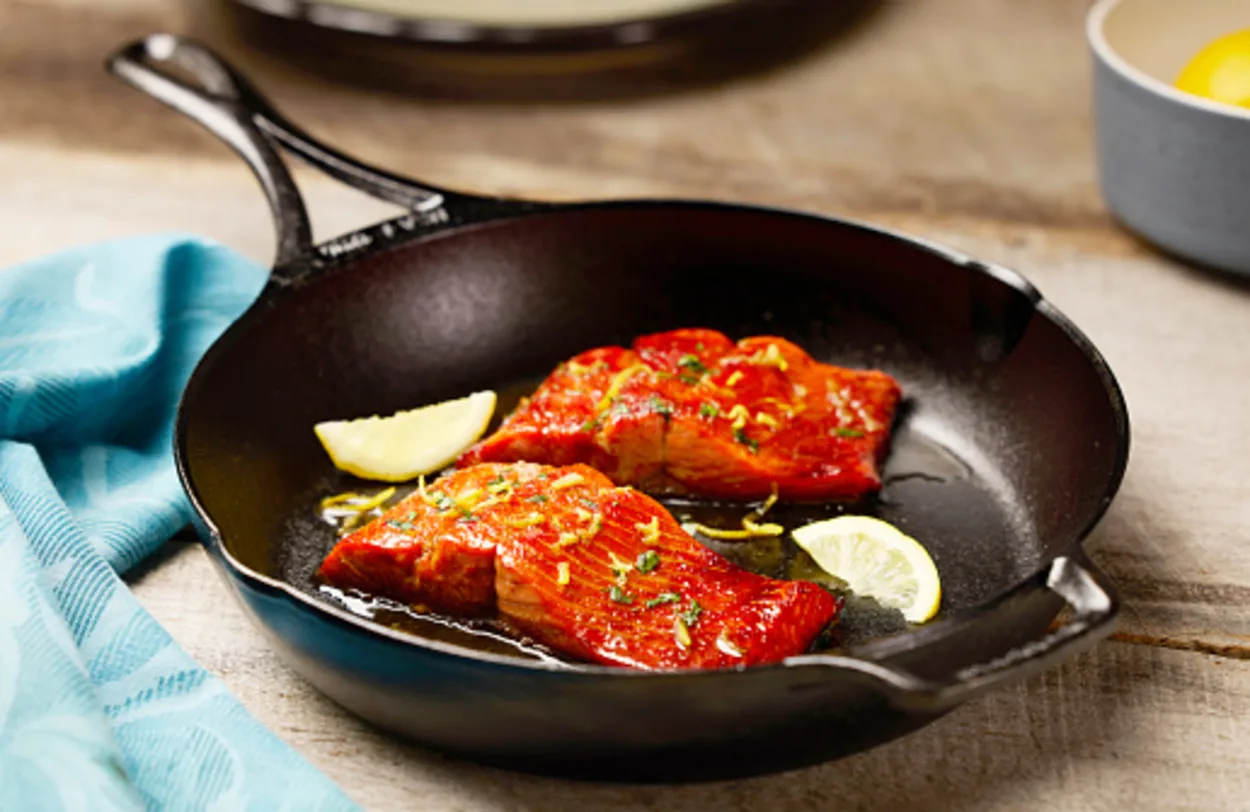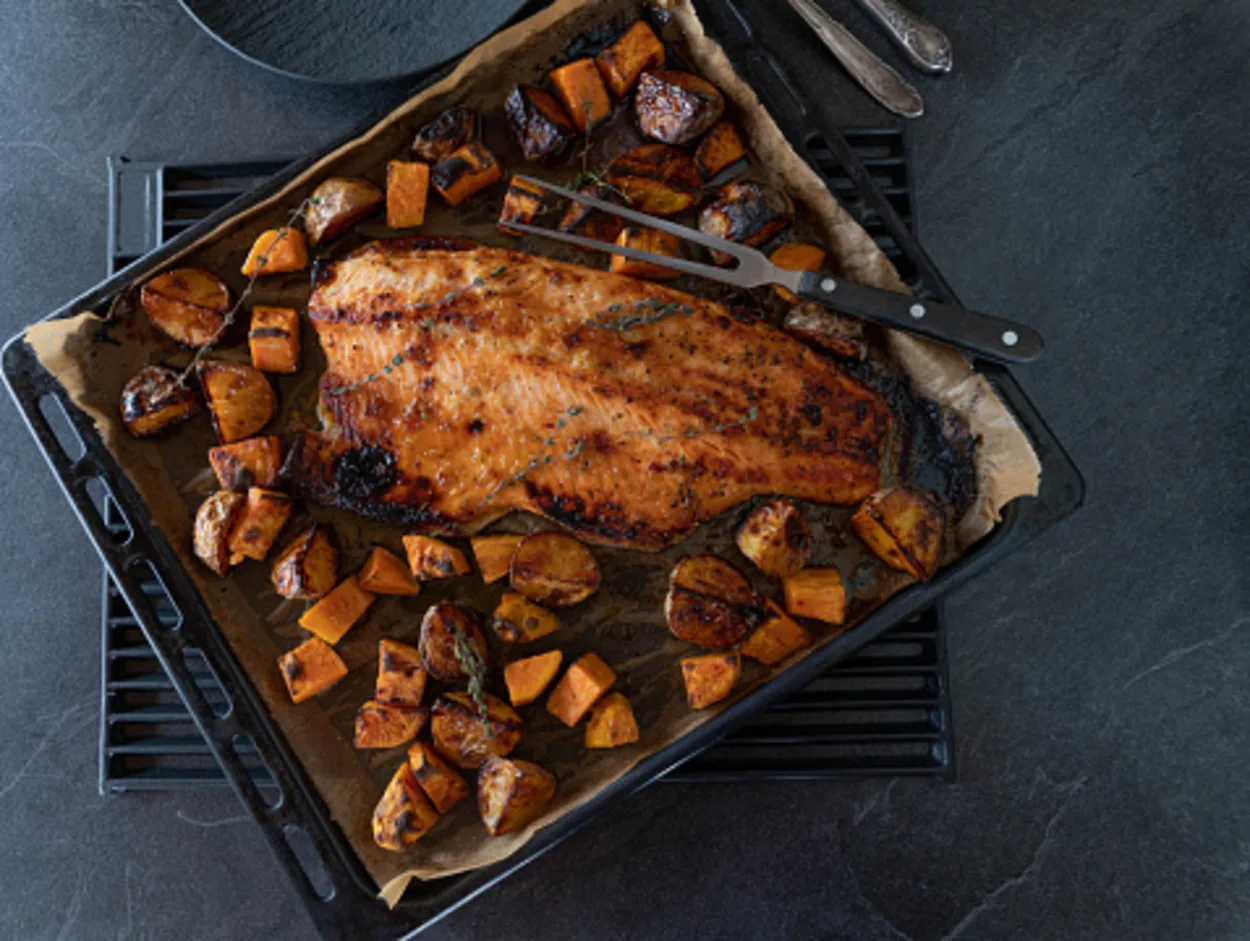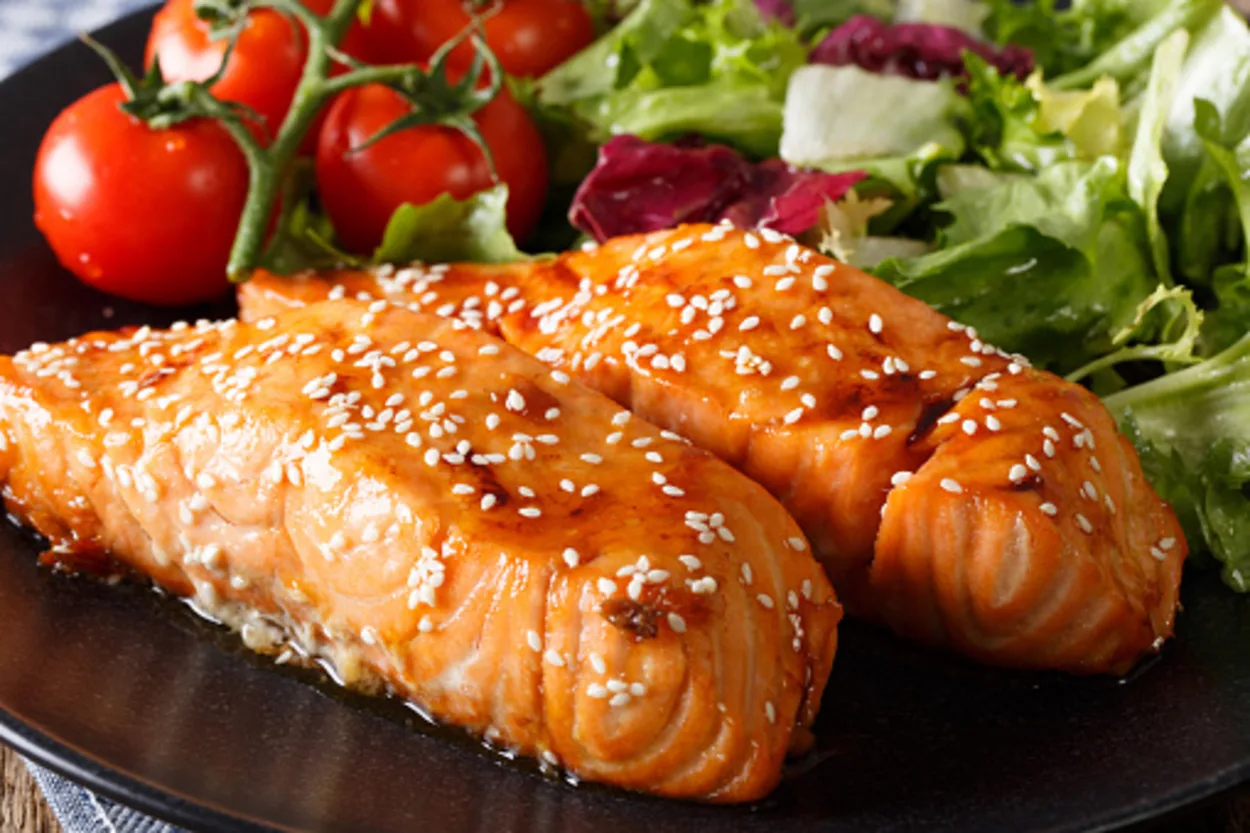Salmon made with honey and mustard is a healthy and fulfilling dish made in under 15 minutes. There is something unreplaceable about this glaze when they are mixed, making it difficult to get any hate.
The sweetness of honey combined with the tingly taste of mustard over tendered salmon fillet makes a meal stand out. You can pair it with rice, cauliflower, mashed potatoes, and even with quoins to make a delectable lunch, dinner, or date night meal.
Well, honey mustard salmon made in the air fryer is one of them. It tastes like heaven and is so easy to make that you just have to put it in the air fryer basket and it’s ready to be served, with no extra effort and totally no mess.
A plated tender and flaked air fryer honey mustard salmon topped with lemon slices and a leafy salad sounds so good that you might want to jump right onto the recipe, isn’t it?
So without further ado, let’s explore the world, brushed up with the glaze.
What temperature should salmon be cooked at?
To make salmon flaky, 380 Fahrenheit is the ideally calculated temperature for it.
Place the seasoned salmon (skin down) in the air fryer with the parchment paper lined in. Preheat your air fryer to 380F for 2-3 minutes, then place the basket in its place.
Let it cook for 10–12 minutes in total. The salmon will be cooked with tenders on the thickest part, giving it a crispy skin. Check for the doneness of the thermometer. If it reads 145F, then it’s good.
Take out the salmon, brush it up with honey mustard sauce, and serve it warm.
Is it better to bake salmon at 350F or 400F?

Neither 350F nor 400F, the best option is 380F, and here’s why.
To cook salmon, you need to pay attention to every little detail. Usually, it takes only 10–12 minutes in an air fryer at 380F for the perfect cookout.
If you preheat the fryer to 350F at first, the salmon’s outer layer will cook slowly without a good texture. On the other hand, if cooked at 400F, the skin will crisp up faster before cooking the insides, hence resulting in a burnt and smokey taste in most cases.
It’s better to choose the option that comes in between both of them so that you have salmon with a balanced texture and taste.
Can you eat salmon skin?
The skin is the best and most nutritious part of any fish you are about to eat, and it is the healthiest too.
Eating them is an excellent addition because it makes you better. After all, they are enriched with essential nutrients like omega3, vitamin D, B12, phosphorous, and other uncountable nutrients.
There is another advantage it holds. The skin will provide a barrier for moisture and nutrients while protecting the salmon flesh from burning unexpectedly.
However, it still depends on your preference whether to remove the skin or not, but there’s a source and quality is the main thing to consider when buying salmon or any other fish.
What is the best method for cooking salmon?

Roasting salmon in the air fryer is the secret to a succulent fish that doesn’t need constant attention. You must have seasoned it well and waited for it to come out as mouthwatering food.
Air frying balance out the temperature so that salmon cooks on the controlled conventional heat rather than high flames. However, the second best method you can try is probably pan-frying which gives salmon the perfect crunchy skin with juicy fillet, but nothing beats the air fryer.
Because cooking salmon in an air fryer won’t need you to transfer it to the oven after getting seared on the stovetop. A steady basket will give you all the reasons to use the air fryer again and again.
How do you cook salmon without drying it out?
To cook salmon without drying it, bake it in an air fryer with gentle heat rather than in any highly heated appliance that would ruin the texture and taste. But if mistakes have been made, remember these parts to make a delectable salmon fish next time.
- Slow-roasting: The gentle heat of the fryer makes this possible and provides you with the best-eaten salmon fillet.
- Olive oil or lemon: Rubbing two of these on the salmon piece will create the barrier making sure the important nutrients and moisture are locked in. If you don’t prefer the great olive oil, you can always have your choice of oil or maybe just some cooking spray.
- Skin: Don’t pull out the skin off of the salmon, this stops the heat to hit on the fillet directly and never overcooks.
What time is adequate to brush sauce on salmon?
Again, it all depends on what you prefer.
Some people like to brush it before cooking, and some people do it after, but I put the sauce on after it’s cooked while having a crunchy texture. Both of these parts have their importance.
Putting the sauce on the salmon early will adhere to the seasoning and rub more firmly on the flesh, while the vinegar in the sauce will tenderize the fillet because the moisture attracts heat. Also, the mustard adds a barky and smokey flavor to the salmon.
This is the reason some people like to put on the sauce after cooking the salmon, so they can taste the authentic juicy flavors.
What condiments go well with salmon?

Unfortunately, salmon is most popular with a honey-mustard combination. Unfortunately, it might not be the taste everyone’s looking for.
No need to worry; the following combinations will undoubtedly give you a reason to try salmon in a new way:
- Yogurt mixed with dill
- Tomatillo Salsa Verde
- Miso glaze
- Teriyaki sauce
- Butter with garlic and lemon zest
Is honey mustard healthy?
No really. When honey and mustard are mixed, they form a dressing that is too high in sugar content and fat.
As the saying goes, favorite things come off with losing something. Hence, it is proved here, to have the delicious honey mustard salmon, you need to give up the weight-losing thoughts for some time.
Honey mustard sure gives that sweet tangy taste that’s nowhere to be found, but it can pose some serious problems for weight gain and metabolism. However, eating it by tracking the nutrients will give you a reason to have a cheat day often.
Nutritional value:
The salmon with honey mustard might be the healthiest fish out there to eat, but all these combinations will give off the highest calorie count so you need to slow it down and have a look at what they offer altogether.
Here is a nutritional table for your convenience:
| Nutrition | Per serving |
| Calorie | 330 |
| Total fat | 18g |
| Cholesterol | 89mg |
| Sodium | 754mg |
| Potassium | 570mg |
| Total carbohydrate | 9.5g |
| Proteins | 32g |
A single serving of 169g salmon gives 330 calories with additional fiber like calcium, iron, phosphor, and other supplements, which is surely good for good health. But if you are a gym enthusiast, you might have to look out for the honey mustard salmon only for controlled weight purposes.
What can I put on top of the salmon?
There are endless choices to make for seasoning the topping of the salmon if you don’t like the standard salt and pepper. Here are some of my preferred ones that you can rely on:
- Butter with parsley and thyme
- Brown sugar with lemon zest and maple syrup
- Mayonnaise, minced garlic, and paprika
- Sriracha sauce with yogurt or cream cheese
- Dill, basil, or bay leaves with oil or melted butter
Tips and tricks to make eye-pleasing salmon
- Submerging the fish into milk will remove the fleshy smell.
- To stop the albumin protein (white matter oozing out of salmon) from appearing again and again, all you have to is putting the fillet in the concentrated brine (made with water and salt).
- Don’t rub the salt way before the cooking, it will break the proteins hence resulting in dry and broken salmon fillets.
- Rub olive oil to stick the dry rub onto the fish perfectly.
- You can sprinkle some brown sugar for a sweet and crunchy texture on the outside part of the salmon.
- Remove the scales from the salmon skin.
- Put the skin-side down in the air fryer basket but with the parchment paper lining.
- Brush the sauce on the salmon fillet after it cooks. You can give it as it is or let them have 1-2 minutes in the air fryer for a warm taste.
How To Cook Honey Mustard Salmon In Air Fryer?
Ingredients:
- Salmon
- Salt
- Pepper
- Mustard
- Honey
- Olive oil
- Cooking spray
Directions:
- Lightly drizzle olive oil on the salmon then season with salt and pepper according to your preferred taste.
- In a bowl, mix both, honey and mustard. Spread the sauce evenly on the salmon portion with a spoon or brush.
- Place the fillets (skin-side down) in the air fryer basket with or without a foil Lightly sprayed with cooking spray.
- Close the basket and let it cook for 10-12 minutes at 380 Fahrenheit, flipping it mid-cooking.
- Once the cooking time is up, check the doneness using a fork or a thermometer having a reading of 145F. Serve hot.
Save a little bit of honey mustard sauce to drizzle on the salmon afterward for more flavor.
How many Fillets Fit In A Basket For An Air Fryer?
The breadth of the fillets and the size of your air fryer will determine how many fillets you can fit inside at once.
What works great for me is that I can typically fit three fillets with plenty to spare in my air fryer. However, I would fry 2 fillets at a time if I wanted to make 4 in total.
How Long Should You Air Fry Salmon?
Salmon is cooked through when it starts to flake easily and the thickest part’s center still has a slightly transparent appearance but does not appear raw.
You must have an immediate read meat thermometer if you want the BEST outcomes! If you want to get technical, the interior temperature should read roughly 145°F/62.7°C.
SUMMARY:
- Honey mustard salmon fish is luxurious, indulgent, and packed with proteins.
- It’s a versatile fish but still pairs up with so many herbs or spices resulting in a tendered and delicious meal.
- Salmon is a feeble fish hence requires you to follow the instructions and tips to get a delicious meal.
- Making salmon fish in an air fryer combined with sauce tastes out of this world.
- Air frying requires no extra preparation, no or just a slight oil drizzle, and cleaning is just like breeze.
- Air-fried salmon have technical and health benefits over so many of the cooking methods.
- Even if salmon is air fried, it is important to check the internal temperature to be 145 Fahrenheit degrees.
